Strategic Analysis of Devonport Chocolates: A Comprehensive Case Study
VerifiedAdded on 2021/04/21
|19
|4257
|40
Case Study
AI Summary
This case study provides a comprehensive analysis of Devonport Chocolates, a leading chocolate producer in New Zealand. It begins with an environmental analysis using PESTLE framework, examining political, economic, social, and technological factors impacting the company. Porter's Five Forces analysis assesses the competitive landscape, including buyer and supplier power, rivalry, and the threat of substitutes and new entrants. The McKinsey 7S model evaluates the company's strategy, structure, systems, shared values, style, staff, and skills. The study then differentiates between strategic and operational plans, outlining strategic goals for expansion, including building culture, decreasing employee turnover, increasing product portfolio, and gaining market position. Control mechanisms like feedforward, concurrent, and feedback are discussed. The study concludes by examining business processes, physical resources, and systems related to expansion, including human resources, compliance, and finance. Various resource systems are also highlighted. Finally, a continuous improvement technique using a think tank is suggested. This document is a comprehensive analysis of the Devonport Chocolates case study, exploring business strategies and frameworks.
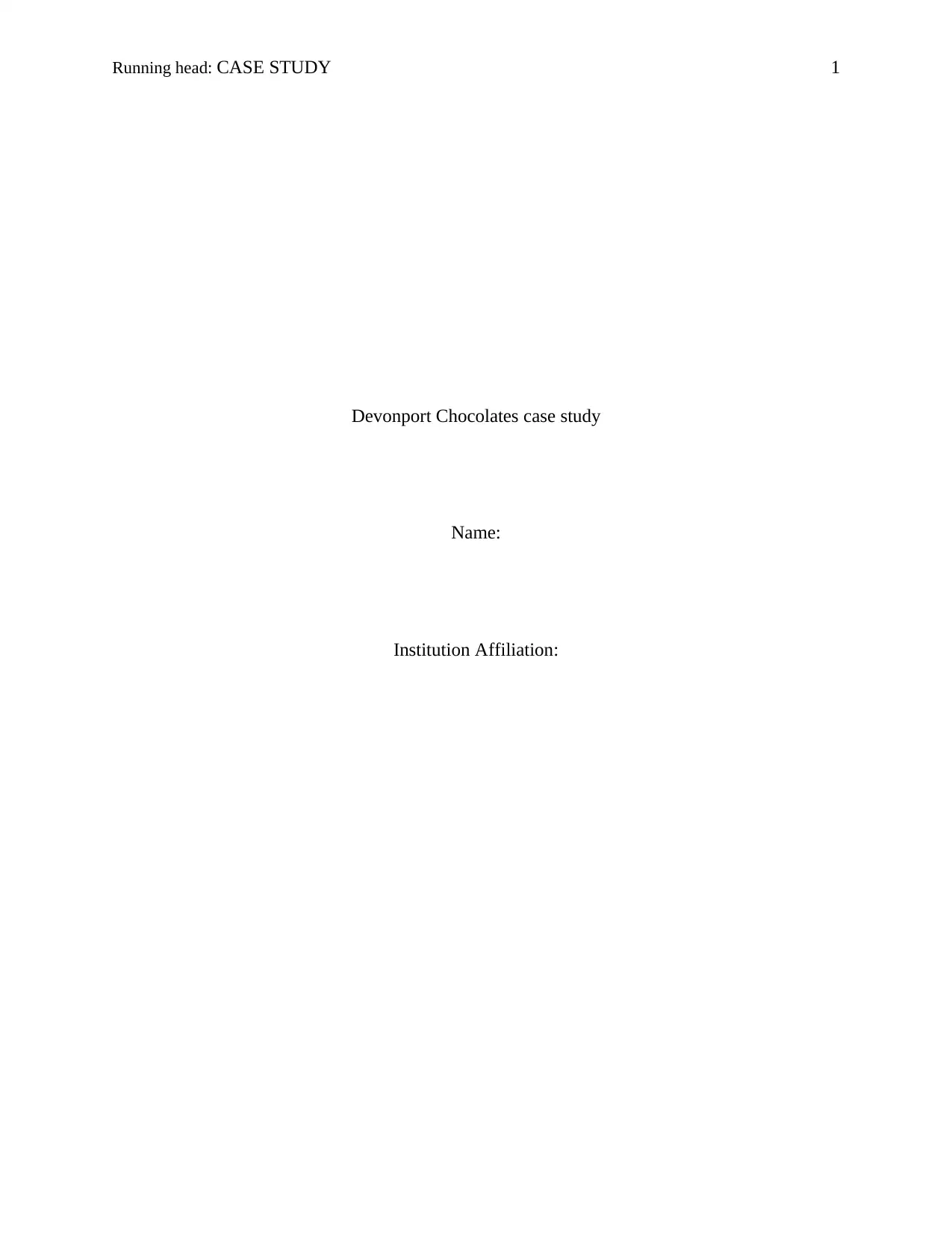
Running head: CASE STUDY 1
Devonport Chocolates case study
Name:
Institution Affiliation:
Devonport Chocolates case study
Name:
Institution Affiliation:
Paraphrase This Document
Need a fresh take? Get an instant paraphrase of this document with our AI Paraphraser
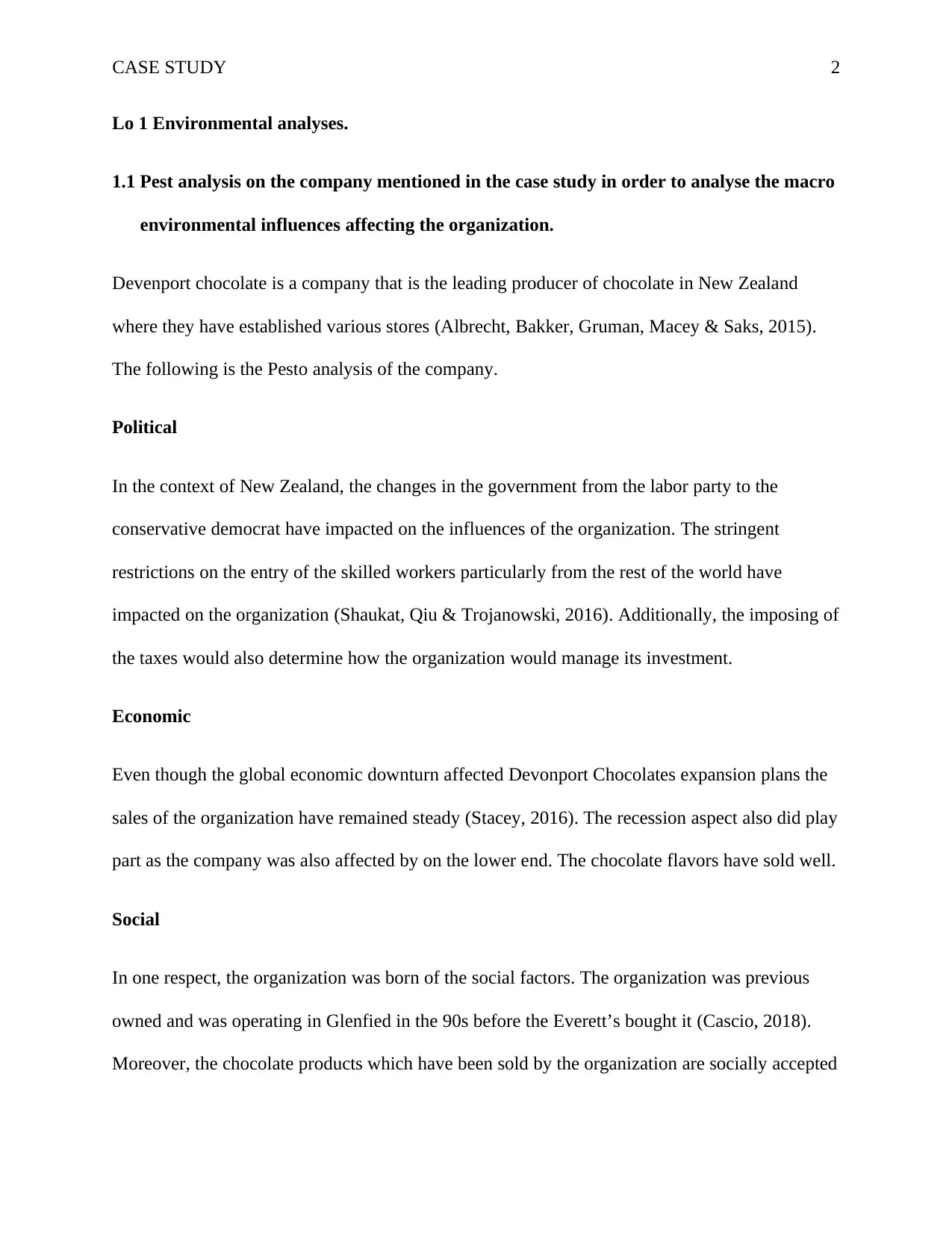
CASE STUDY 2
Lo 1 Environmental analyses.
1.1 Pest analysis on the company mentioned in the case study in order to analyse the macro
environmental influences affecting the organization.
Devenport chocolate is a company that is the leading producer of chocolate in New Zealand
where they have established various stores (Albrecht, Bakker, Gruman, Macey & Saks, 2015).
The following is the Pesto analysis of the company.
Political
In the context of New Zealand, the changes in the government from the labor party to the
conservative democrat have impacted on the influences of the organization. The stringent
restrictions on the entry of the skilled workers particularly from the rest of the world have
impacted on the organization (Shaukat, Qiu & Trojanowski, 2016). Additionally, the imposing of
the taxes would also determine how the organization would manage its investment.
Economic
Even though the global economic downturn affected Devonport Chocolates expansion plans the
sales of the organization have remained steady (Stacey, 2016). The recession aspect also did play
part as the company was also affected by on the lower end. The chocolate flavors have sold well.
Social
In one respect, the organization was born of the social factors. The organization was previous
owned and was operating in Glenfied in the 90s before the Everett’s bought it (Cascio, 2018).
Moreover, the chocolate products which have been sold by the organization are socially accepted
Lo 1 Environmental analyses.
1.1 Pest analysis on the company mentioned in the case study in order to analyse the macro
environmental influences affecting the organization.
Devenport chocolate is a company that is the leading producer of chocolate in New Zealand
where they have established various stores (Albrecht, Bakker, Gruman, Macey & Saks, 2015).
The following is the Pesto analysis of the company.
Political
In the context of New Zealand, the changes in the government from the labor party to the
conservative democrat have impacted on the influences of the organization. The stringent
restrictions on the entry of the skilled workers particularly from the rest of the world have
impacted on the organization (Shaukat, Qiu & Trojanowski, 2016). Additionally, the imposing of
the taxes would also determine how the organization would manage its investment.
Economic
Even though the global economic downturn affected Devonport Chocolates expansion plans the
sales of the organization have remained steady (Stacey, 2016). The recession aspect also did play
part as the company was also affected by on the lower end. The chocolate flavors have sold well.
Social
In one respect, the organization was born of the social factors. The organization was previous
owned and was operating in Glenfied in the 90s before the Everett’s bought it (Cascio, 2018).
Moreover, the chocolate products which have been sold by the organization are socially accepted
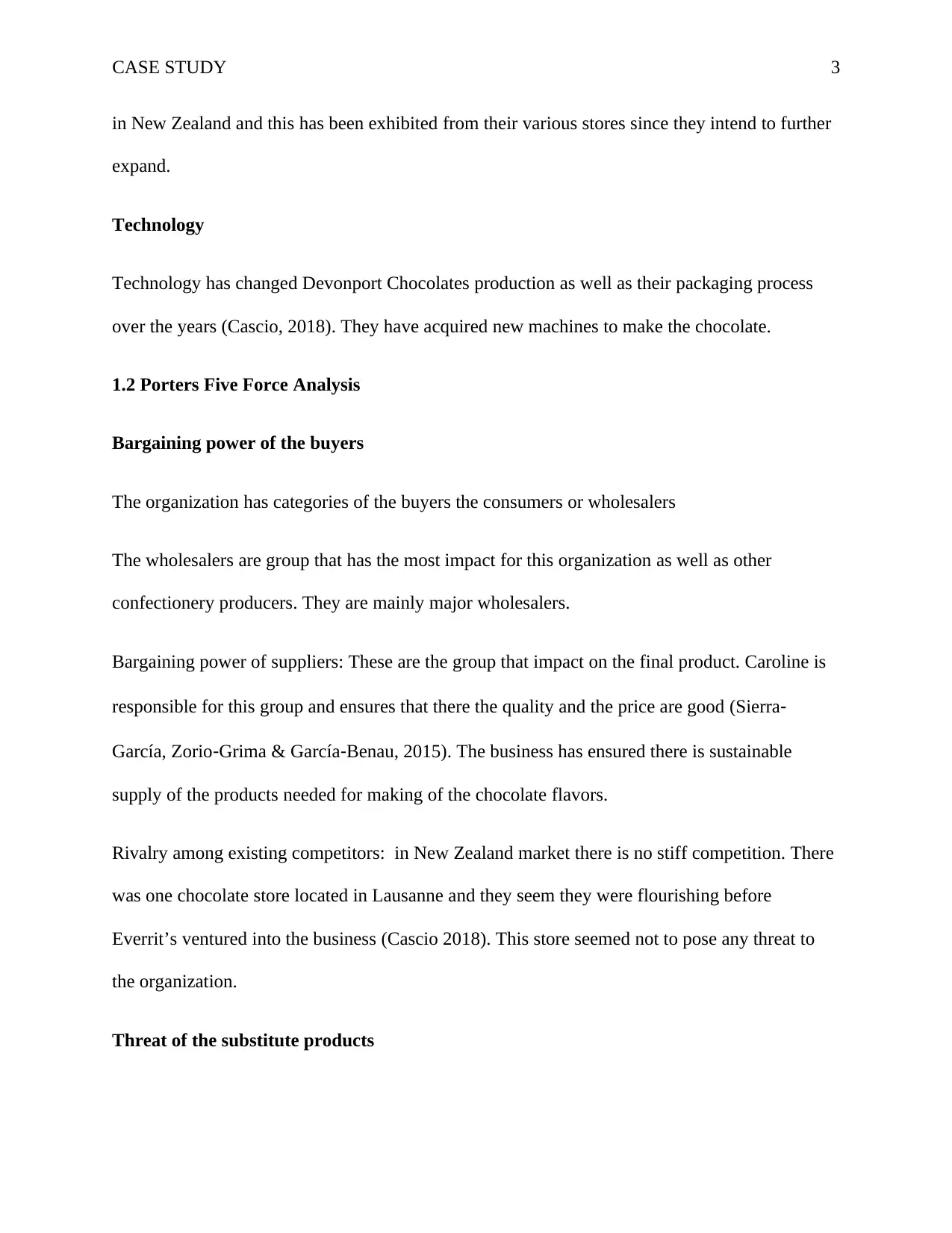
CASE STUDY 3
in New Zealand and this has been exhibited from their various stores since they intend to further
expand.
Technology
Technology has changed Devonport Chocolates production as well as their packaging process
over the years (Cascio, 2018). They have acquired new machines to make the chocolate.
1.2 Porters Five Force Analysis
Bargaining power of the buyers
The organization has categories of the buyers the consumers or wholesalers
The wholesalers are group that has the most impact for this organization as well as other
confectionery producers. They are mainly major wholesalers.
Bargaining power of suppliers: These are the group that impact on the final product. Caroline is
responsible for this group and ensures that there the quality and the price are good (Sierra‐
García, Zorio‐Grima & García‐Benau, 2015). The business has ensured there is sustainable
supply of the products needed for making of the chocolate flavors.
Rivalry among existing competitors: in New Zealand market there is no stiff competition. There
was one chocolate store located in Lausanne and they seem they were flourishing before
Everrit’s ventured into the business (Cascio 2018). This store seemed not to pose any threat to
the organization.
Threat of the substitute products
in New Zealand and this has been exhibited from their various stores since they intend to further
expand.
Technology
Technology has changed Devonport Chocolates production as well as their packaging process
over the years (Cascio, 2018). They have acquired new machines to make the chocolate.
1.2 Porters Five Force Analysis
Bargaining power of the buyers
The organization has categories of the buyers the consumers or wholesalers
The wholesalers are group that has the most impact for this organization as well as other
confectionery producers. They are mainly major wholesalers.
Bargaining power of suppliers: These are the group that impact on the final product. Caroline is
responsible for this group and ensures that there the quality and the price are good (Sierra‐
García, Zorio‐Grima & García‐Benau, 2015). The business has ensured there is sustainable
supply of the products needed for making of the chocolate flavors.
Rivalry among existing competitors: in New Zealand market there is no stiff competition. There
was one chocolate store located in Lausanne and they seem they were flourishing before
Everrit’s ventured into the business (Cascio 2018). This store seemed not to pose any threat to
the organization.
Threat of the substitute products
You're viewing a preview
Unlock full access by subscribing today!
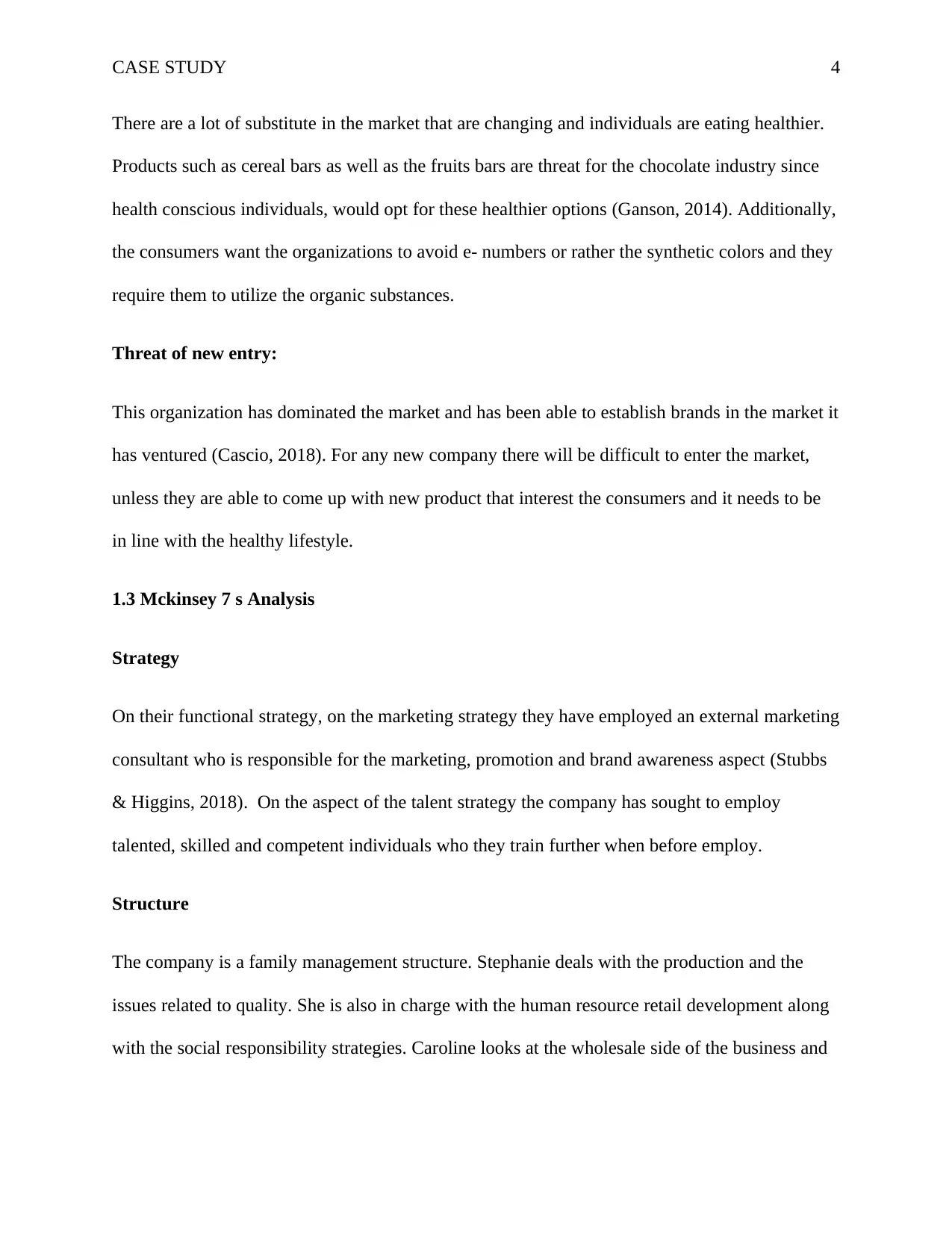
CASE STUDY 4
There are a lot of substitute in the market that are changing and individuals are eating healthier.
Products such as cereal bars as well as the fruits bars are threat for the chocolate industry since
health conscious individuals, would opt for these healthier options (Ganson, 2014). Additionally,
the consumers want the organizations to avoid e- numbers or rather the synthetic colors and they
require them to utilize the organic substances.
Threat of new entry:
This organization has dominated the market and has been able to establish brands in the market it
has ventured (Cascio, 2018). For any new company there will be difficult to enter the market,
unless they are able to come up with new product that interest the consumers and it needs to be
in line with the healthy lifestyle.
1.3 Mckinsey 7 s Analysis
Strategy
On their functional strategy, on the marketing strategy they have employed an external marketing
consultant who is responsible for the marketing, promotion and brand awareness aspect (Stubbs
& Higgins, 2018). On the aspect of the talent strategy the company has sought to employ
talented, skilled and competent individuals who they train further when before employ.
Structure
The company is a family management structure. Stephanie deals with the production and the
issues related to quality. She is also in charge with the human resource retail development along
with the social responsibility strategies. Caroline looks at the wholesale side of the business and
There are a lot of substitute in the market that are changing and individuals are eating healthier.
Products such as cereal bars as well as the fruits bars are threat for the chocolate industry since
health conscious individuals, would opt for these healthier options (Ganson, 2014). Additionally,
the consumers want the organizations to avoid e- numbers or rather the synthetic colors and they
require them to utilize the organic substances.
Threat of new entry:
This organization has dominated the market and has been able to establish brands in the market it
has ventured (Cascio, 2018). For any new company there will be difficult to enter the market,
unless they are able to come up with new product that interest the consumers and it needs to be
in line with the healthy lifestyle.
1.3 Mckinsey 7 s Analysis
Strategy
On their functional strategy, on the marketing strategy they have employed an external marketing
consultant who is responsible for the marketing, promotion and brand awareness aspect (Stubbs
& Higgins, 2018). On the aspect of the talent strategy the company has sought to employ
talented, skilled and competent individuals who they train further when before employ.
Structure
The company is a family management structure. Stephanie deals with the production and the
issues related to quality. She is also in charge with the human resource retail development along
with the social responsibility strategies. Caroline looks at the wholesale side of the business and
Paraphrase This Document
Need a fresh take? Get an instant paraphrase of this document with our AI Paraphraser
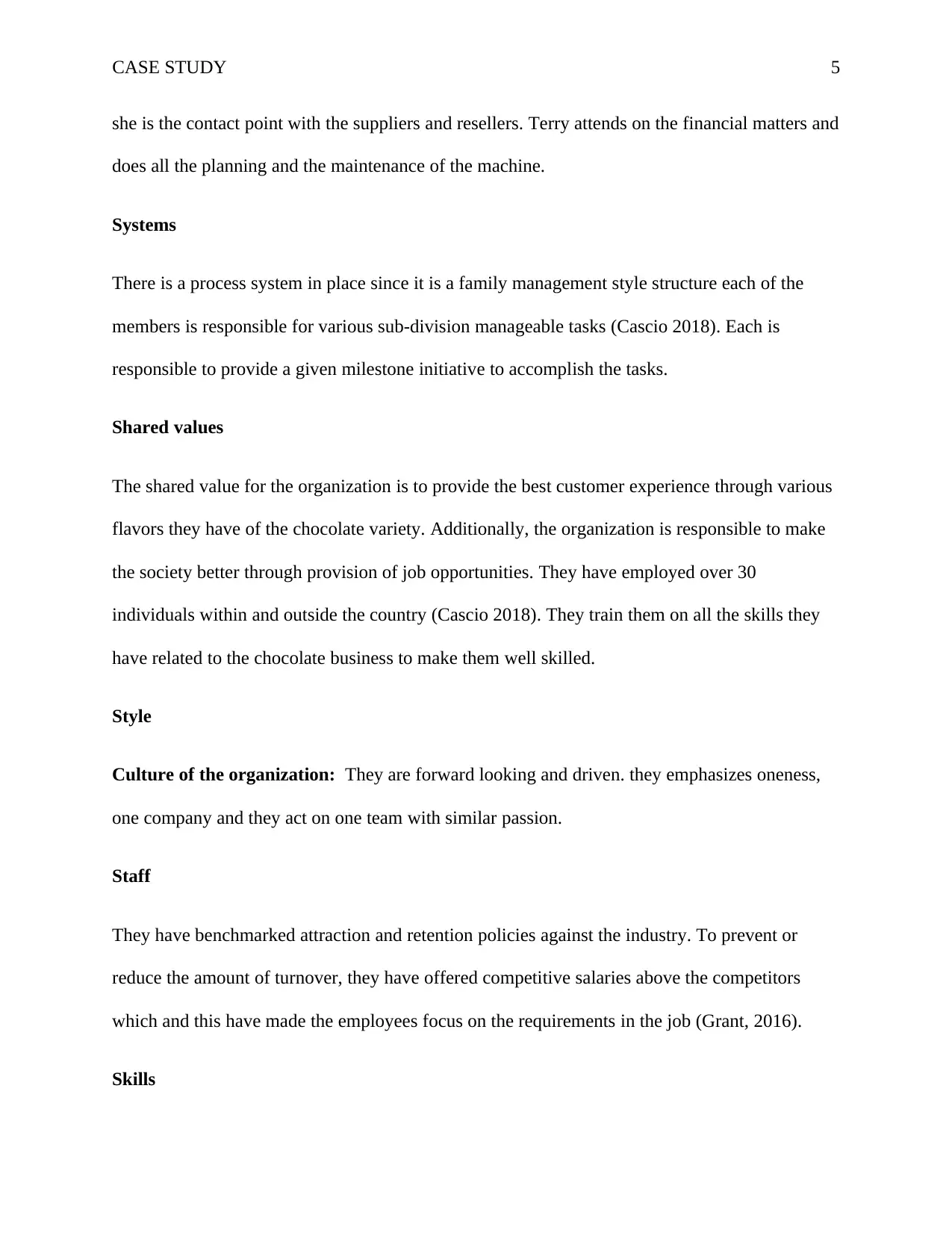
CASE STUDY 5
she is the contact point with the suppliers and resellers. Terry attends on the financial matters and
does all the planning and the maintenance of the machine.
Systems
There is a process system in place since it is a family management style structure each of the
members is responsible for various sub-division manageable tasks (Cascio 2018). Each is
responsible to provide a given milestone initiative to accomplish the tasks.
Shared values
The shared value for the organization is to provide the best customer experience through various
flavors they have of the chocolate variety. Additionally, the organization is responsible to make
the society better through provision of job opportunities. They have employed over 30
individuals within and outside the country (Cascio 2018). They train them on all the skills they
have related to the chocolate business to make them well skilled.
Style
Culture of the organization: They are forward looking and driven. they emphasizes oneness,
one company and they act on one team with similar passion.
Staff
They have benchmarked attraction and retention policies against the industry. To prevent or
reduce the amount of turnover, they have offered competitive salaries above the competitors
which and this have made the employees focus on the requirements in the job (Grant, 2016).
Skills
she is the contact point with the suppliers and resellers. Terry attends on the financial matters and
does all the planning and the maintenance of the machine.
Systems
There is a process system in place since it is a family management style structure each of the
members is responsible for various sub-division manageable tasks (Cascio 2018). Each is
responsible to provide a given milestone initiative to accomplish the tasks.
Shared values
The shared value for the organization is to provide the best customer experience through various
flavors they have of the chocolate variety. Additionally, the organization is responsible to make
the society better through provision of job opportunities. They have employed over 30
individuals within and outside the country (Cascio 2018). They train them on all the skills they
have related to the chocolate business to make them well skilled.
Style
Culture of the organization: They are forward looking and driven. they emphasizes oneness,
one company and they act on one team with similar passion.
Staff
They have benchmarked attraction and retention policies against the industry. To prevent or
reduce the amount of turnover, they have offered competitive salaries above the competitors
which and this have made the employees focus on the requirements in the job (Grant, 2016).
Skills
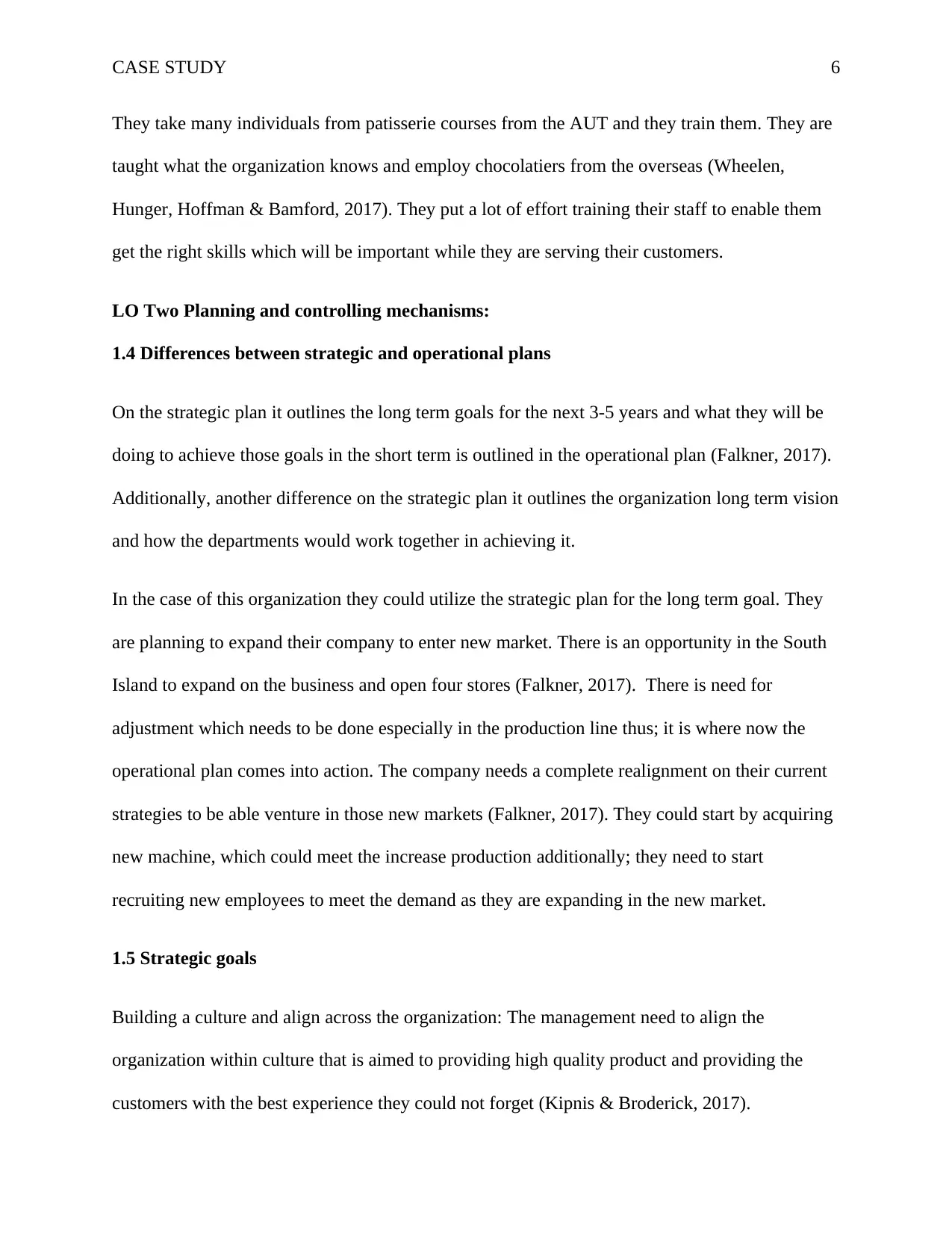
CASE STUDY 6
They take many individuals from patisserie courses from the AUT and they train them. They are
taught what the organization knows and employ chocolatiers from the overseas (Wheelen,
Hunger, Hoffman & Bamford, 2017). They put a lot of effort training their staff to enable them
get the right skills which will be important while they are serving their customers.
LO Two Planning and controlling mechanisms:
1.4 Differences between strategic and operational plans
On the strategic plan it outlines the long term goals for the next 3-5 years and what they will be
doing to achieve those goals in the short term is outlined in the operational plan (Falkner, 2017).
Additionally, another difference on the strategic plan it outlines the organization long term vision
and how the departments would work together in achieving it.
In the case of this organization they could utilize the strategic plan for the long term goal. They
are planning to expand their company to enter new market. There is an opportunity in the South
Island to expand on the business and open four stores (Falkner, 2017). There is need for
adjustment which needs to be done especially in the production line thus; it is where now the
operational plan comes into action. The company needs a complete realignment on their current
strategies to be able venture in those new markets (Falkner, 2017). They could start by acquiring
new machine, which could meet the increase production additionally; they need to start
recruiting new employees to meet the demand as they are expanding in the new market.
1.5 Strategic goals
Building a culture and align across the organization: The management need to align the
organization within culture that is aimed to providing high quality product and providing the
customers with the best experience they could not forget (Kipnis & Broderick, 2017).
They take many individuals from patisserie courses from the AUT and they train them. They are
taught what the organization knows and employ chocolatiers from the overseas (Wheelen,
Hunger, Hoffman & Bamford, 2017). They put a lot of effort training their staff to enable them
get the right skills which will be important while they are serving their customers.
LO Two Planning and controlling mechanisms:
1.4 Differences between strategic and operational plans
On the strategic plan it outlines the long term goals for the next 3-5 years and what they will be
doing to achieve those goals in the short term is outlined in the operational plan (Falkner, 2017).
Additionally, another difference on the strategic plan it outlines the organization long term vision
and how the departments would work together in achieving it.
In the case of this organization they could utilize the strategic plan for the long term goal. They
are planning to expand their company to enter new market. There is an opportunity in the South
Island to expand on the business and open four stores (Falkner, 2017). There is need for
adjustment which needs to be done especially in the production line thus; it is where now the
operational plan comes into action. The company needs a complete realignment on their current
strategies to be able venture in those new markets (Falkner, 2017). They could start by acquiring
new machine, which could meet the increase production additionally; they need to start
recruiting new employees to meet the demand as they are expanding in the new market.
1.5 Strategic goals
Building a culture and align across the organization: The management need to align the
organization within culture that is aimed to providing high quality product and providing the
customers with the best experience they could not forget (Kipnis & Broderick, 2017).
You're viewing a preview
Unlock full access by subscribing today!
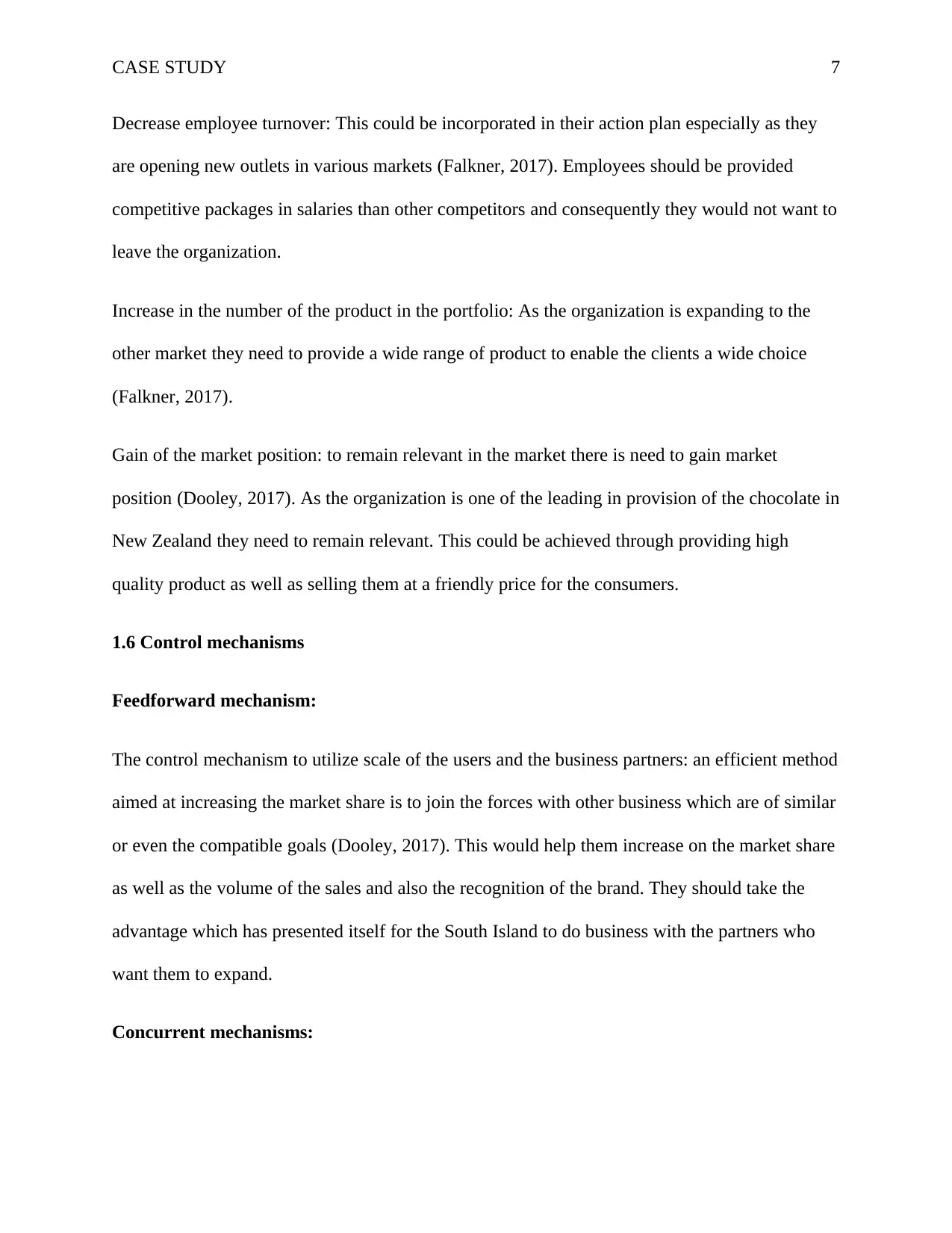
CASE STUDY 7
Decrease employee turnover: This could be incorporated in their action plan especially as they
are opening new outlets in various markets (Falkner, 2017). Employees should be provided
competitive packages in salaries than other competitors and consequently they would not want to
leave the organization.
Increase in the number of the product in the portfolio: As the organization is expanding to the
other market they need to provide a wide range of product to enable the clients a wide choice
(Falkner, 2017).
Gain of the market position: to remain relevant in the market there is need to gain market
position (Dooley, 2017). As the organization is one of the leading in provision of the chocolate in
New Zealand they need to remain relevant. This could be achieved through providing high
quality product as well as selling them at a friendly price for the consumers.
1.6 Control mechanisms
Feedforward mechanism:
The control mechanism to utilize scale of the users and the business partners: an efficient method
aimed at increasing the market share is to join the forces with other business which are of similar
or even the compatible goals (Dooley, 2017). This would help them increase on the market share
as well as the volume of the sales and also the recognition of the brand. They should take the
advantage which has presented itself for the South Island to do business with the partners who
want them to expand.
Concurrent mechanisms:
Decrease employee turnover: This could be incorporated in their action plan especially as they
are opening new outlets in various markets (Falkner, 2017). Employees should be provided
competitive packages in salaries than other competitors and consequently they would not want to
leave the organization.
Increase in the number of the product in the portfolio: As the organization is expanding to the
other market they need to provide a wide range of product to enable the clients a wide choice
(Falkner, 2017).
Gain of the market position: to remain relevant in the market there is need to gain market
position (Dooley, 2017). As the organization is one of the leading in provision of the chocolate in
New Zealand they need to remain relevant. This could be achieved through providing high
quality product as well as selling them at a friendly price for the consumers.
1.6 Control mechanisms
Feedforward mechanism:
The control mechanism to utilize scale of the users and the business partners: an efficient method
aimed at increasing the market share is to join the forces with other business which are of similar
or even the compatible goals (Dooley, 2017). This would help them increase on the market share
as well as the volume of the sales and also the recognition of the brand. They should take the
advantage which has presented itself for the South Island to do business with the partners who
want them to expand.
Concurrent mechanisms:
Paraphrase This Document
Need a fresh take? Get an instant paraphrase of this document with our AI Paraphraser
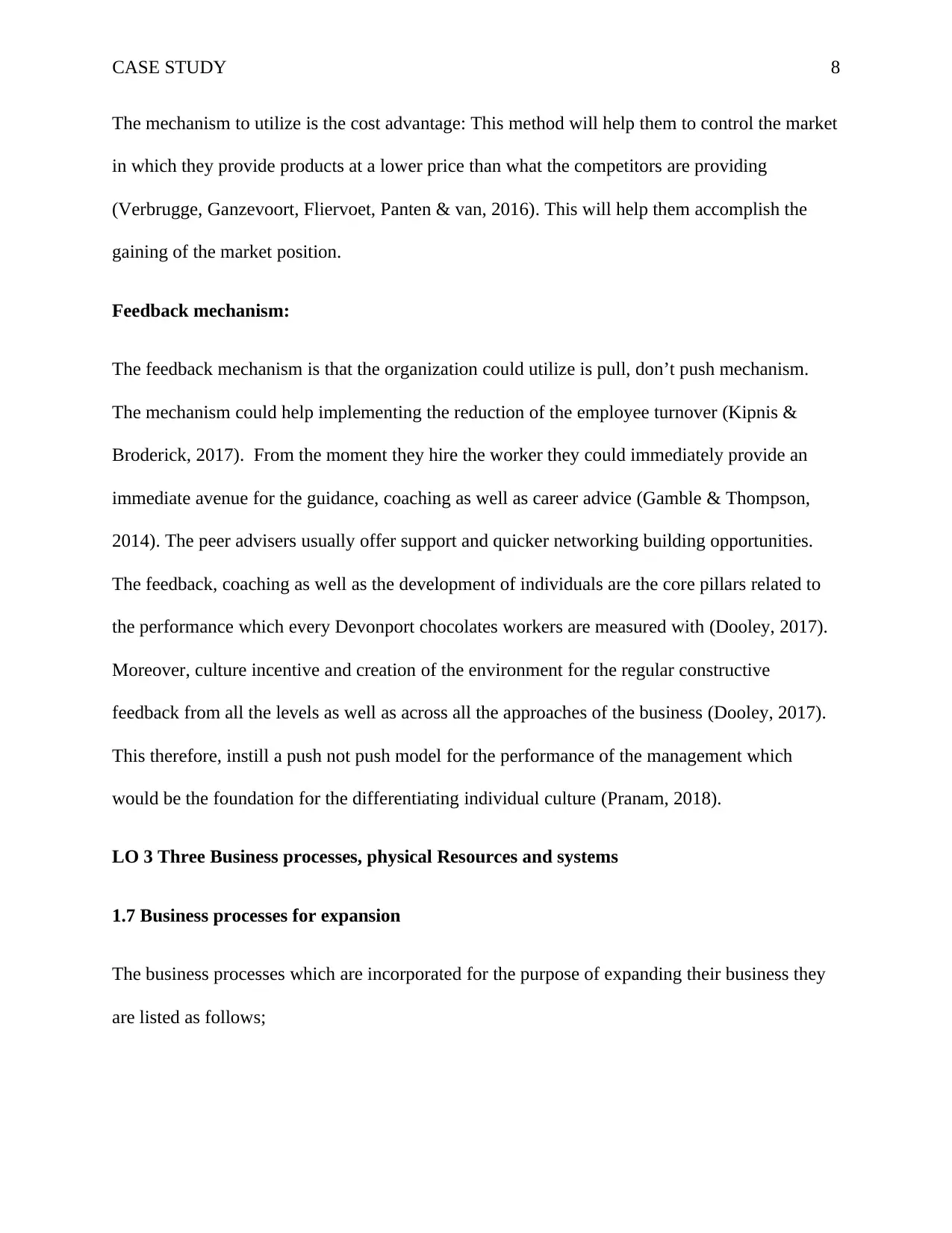
CASE STUDY 8
The mechanism to utilize is the cost advantage: This method will help them to control the market
in which they provide products at a lower price than what the competitors are providing
(Verbrugge, Ganzevoort, Fliervoet, Panten & van, 2016). This will help them accomplish the
gaining of the market position.
Feedback mechanism:
The feedback mechanism is that the organization could utilize is pull, don’t push mechanism.
The mechanism could help implementing the reduction of the employee turnover (Kipnis &
Broderick, 2017). From the moment they hire the worker they could immediately provide an
immediate avenue for the guidance, coaching as well as career advice (Gamble & Thompson,
2014). The peer advisers usually offer support and quicker networking building opportunities.
The feedback, coaching as well as the development of individuals are the core pillars related to
the performance which every Devonport chocolates workers are measured with (Dooley, 2017).
Moreover, culture incentive and creation of the environment for the regular constructive
feedback from all the levels as well as across all the approaches of the business (Dooley, 2017).
This therefore, instill a push not push model for the performance of the management which
would be the foundation for the differentiating individual culture (Pranam, 2018).
LO 3 Three Business processes, physical Resources and systems
1.7 Business processes for expansion
The business processes which are incorporated for the purpose of expanding their business they
are listed as follows;
The mechanism to utilize is the cost advantage: This method will help them to control the market
in which they provide products at a lower price than what the competitors are providing
(Verbrugge, Ganzevoort, Fliervoet, Panten & van, 2016). This will help them accomplish the
gaining of the market position.
Feedback mechanism:
The feedback mechanism is that the organization could utilize is pull, don’t push mechanism.
The mechanism could help implementing the reduction of the employee turnover (Kipnis &
Broderick, 2017). From the moment they hire the worker they could immediately provide an
immediate avenue for the guidance, coaching as well as career advice (Gamble & Thompson,
2014). The peer advisers usually offer support and quicker networking building opportunities.
The feedback, coaching as well as the development of individuals are the core pillars related to
the performance which every Devonport chocolates workers are measured with (Dooley, 2017).
Moreover, culture incentive and creation of the environment for the regular constructive
feedback from all the levels as well as across all the approaches of the business (Dooley, 2017).
This therefore, instill a push not push model for the performance of the management which
would be the foundation for the differentiating individual culture (Pranam, 2018).
LO 3 Three Business processes, physical Resources and systems
1.7 Business processes for expansion
The business processes which are incorporated for the purpose of expanding their business they
are listed as follows;
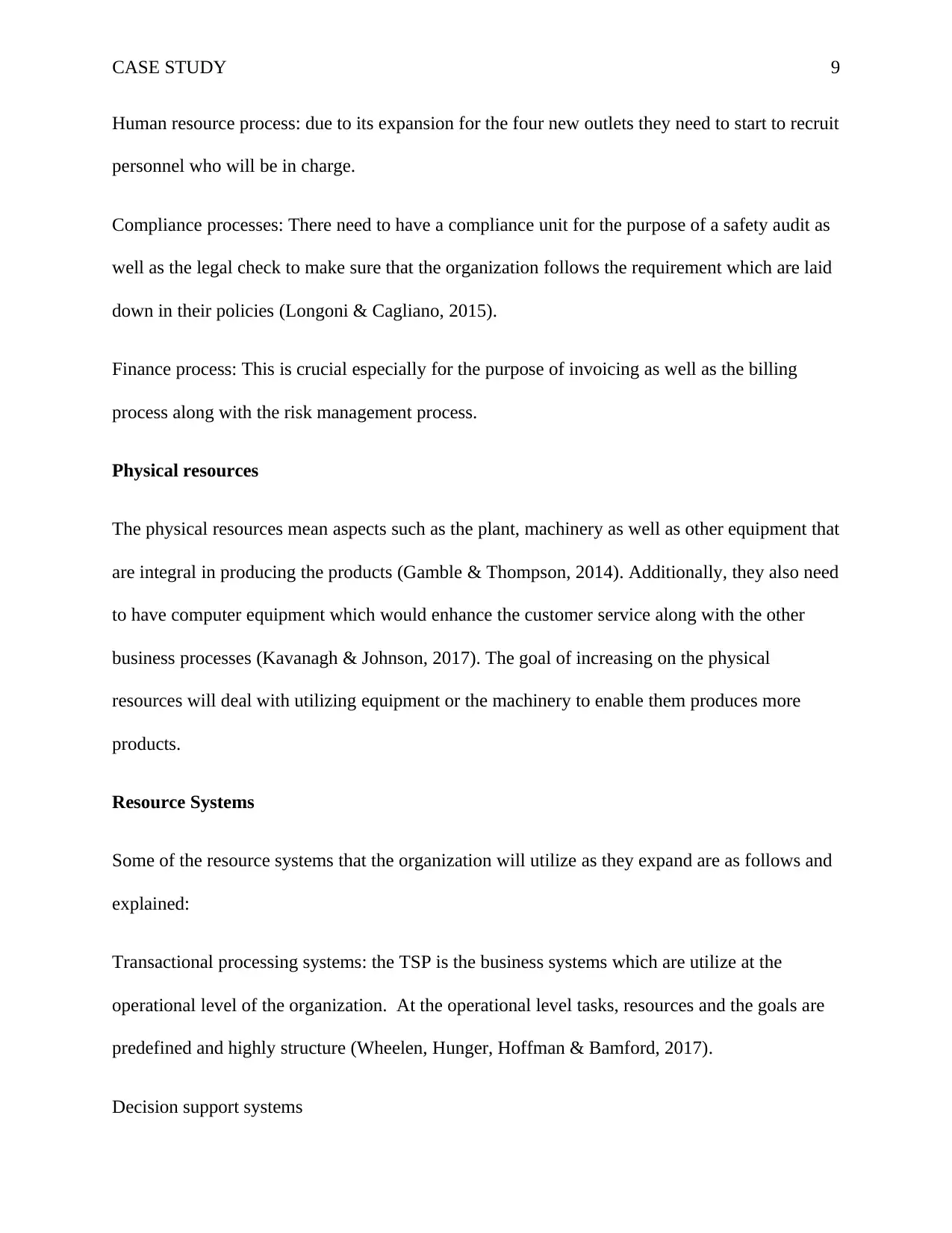
CASE STUDY 9
Human resource process: due to its expansion for the four new outlets they need to start to recruit
personnel who will be in charge.
Compliance processes: There need to have a compliance unit for the purpose of a safety audit as
well as the legal check to make sure that the organization follows the requirement which are laid
down in their policies (Longoni & Cagliano, 2015).
Finance process: This is crucial especially for the purpose of invoicing as well as the billing
process along with the risk management process.
Physical resources
The physical resources mean aspects such as the plant, machinery as well as other equipment that
are integral in producing the products (Gamble & Thompson, 2014). Additionally, they also need
to have computer equipment which would enhance the customer service along with the other
business processes (Kavanagh & Johnson, 2017). The goal of increasing on the physical
resources will deal with utilizing equipment or the machinery to enable them produces more
products.
Resource Systems
Some of the resource systems that the organization will utilize as they expand are as follows and
explained:
Transactional processing systems: the TSP is the business systems which are utilize at the
operational level of the organization. At the operational level tasks, resources and the goals are
predefined and highly structure (Wheelen, Hunger, Hoffman & Bamford, 2017).
Decision support systems
Human resource process: due to its expansion for the four new outlets they need to start to recruit
personnel who will be in charge.
Compliance processes: There need to have a compliance unit for the purpose of a safety audit as
well as the legal check to make sure that the organization follows the requirement which are laid
down in their policies (Longoni & Cagliano, 2015).
Finance process: This is crucial especially for the purpose of invoicing as well as the billing
process along with the risk management process.
Physical resources
The physical resources mean aspects such as the plant, machinery as well as other equipment that
are integral in producing the products (Gamble & Thompson, 2014). Additionally, they also need
to have computer equipment which would enhance the customer service along with the other
business processes (Kavanagh & Johnson, 2017). The goal of increasing on the physical
resources will deal with utilizing equipment or the machinery to enable them produces more
products.
Resource Systems
Some of the resource systems that the organization will utilize as they expand are as follows and
explained:
Transactional processing systems: the TSP is the business systems which are utilize at the
operational level of the organization. At the operational level tasks, resources and the goals are
predefined and highly structure (Wheelen, Hunger, Hoffman & Bamford, 2017).
Decision support systems
You're viewing a preview
Unlock full access by subscribing today!
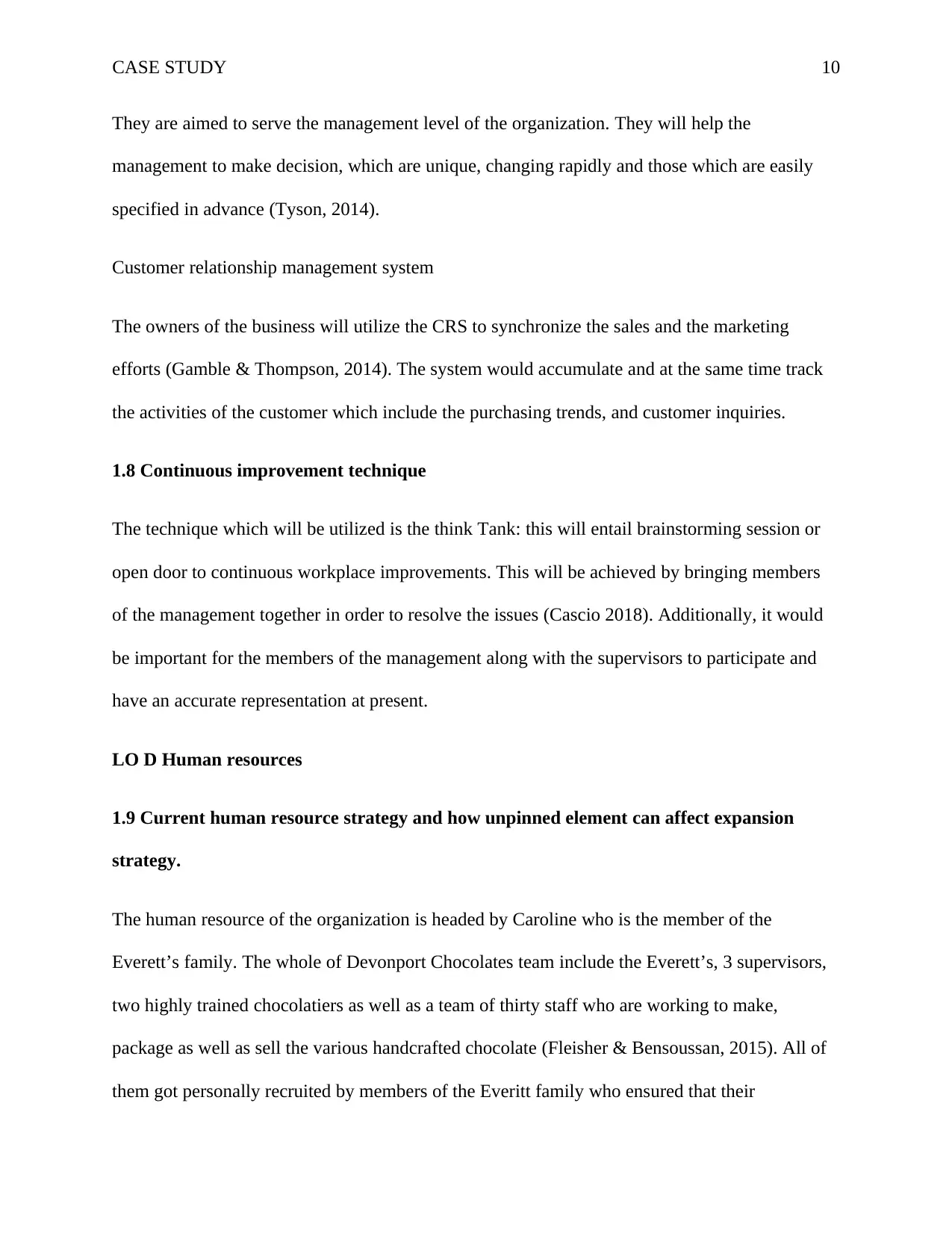
CASE STUDY 10
They are aimed to serve the management level of the organization. They will help the
management to make decision, which are unique, changing rapidly and those which are easily
specified in advance (Tyson, 2014).
Customer relationship management system
The owners of the business will utilize the CRS to synchronize the sales and the marketing
efforts (Gamble & Thompson, 2014). The system would accumulate and at the same time track
the activities of the customer which include the purchasing trends, and customer inquiries.
1.8 Continuous improvement technique
The technique which will be utilized is the think Tank: this will entail brainstorming session or
open door to continuous workplace improvements. This will be achieved by bringing members
of the management together in order to resolve the issues (Cascio 2018). Additionally, it would
be important for the members of the management along with the supervisors to participate and
have an accurate representation at present.
LO D Human resources
1.9 Current human resource strategy and how unpinned element can affect expansion
strategy.
The human resource of the organization is headed by Caroline who is the member of the
Everett’s family. The whole of Devonport Chocolates team include the Everett’s, 3 supervisors,
two highly trained chocolatiers as well as a team of thirty staff who are working to make,
package as well as sell the various handcrafted chocolate (Fleisher & Bensoussan, 2015). All of
them got personally recruited by members of the Everitt family who ensured that their
They are aimed to serve the management level of the organization. They will help the
management to make decision, which are unique, changing rapidly and those which are easily
specified in advance (Tyson, 2014).
Customer relationship management system
The owners of the business will utilize the CRS to synchronize the sales and the marketing
efforts (Gamble & Thompson, 2014). The system would accumulate and at the same time track
the activities of the customer which include the purchasing trends, and customer inquiries.
1.8 Continuous improvement technique
The technique which will be utilized is the think Tank: this will entail brainstorming session or
open door to continuous workplace improvements. This will be achieved by bringing members
of the management together in order to resolve the issues (Cascio 2018). Additionally, it would
be important for the members of the management along with the supervisors to participate and
have an accurate representation at present.
LO D Human resources
1.9 Current human resource strategy and how unpinned element can affect expansion
strategy.
The human resource of the organization is headed by Caroline who is the member of the
Everett’s family. The whole of Devonport Chocolates team include the Everett’s, 3 supervisors,
two highly trained chocolatiers as well as a team of thirty staff who are working to make,
package as well as sell the various handcrafted chocolate (Fleisher & Bensoussan, 2015). All of
them got personally recruited by members of the Everitt family who ensured that their
Paraphrase This Document
Need a fresh take? Get an instant paraphrase of this document with our AI Paraphraser
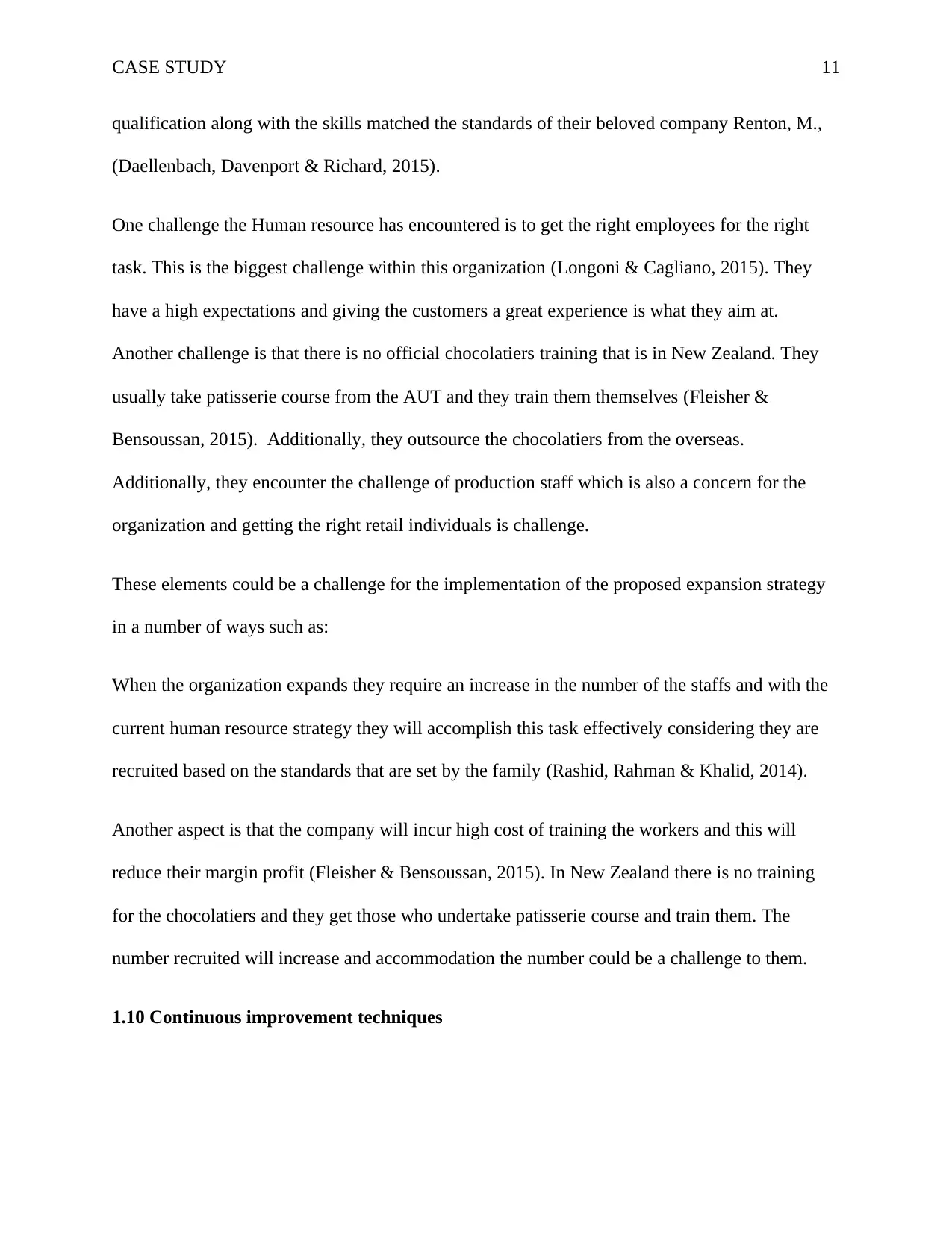
CASE STUDY 11
qualification along with the skills matched the standards of their beloved company Renton, M.,
(Daellenbach, Davenport & Richard, 2015).
One challenge the Human resource has encountered is to get the right employees for the right
task. This is the biggest challenge within this organization (Longoni & Cagliano, 2015). They
have a high expectations and giving the customers a great experience is what they aim at.
Another challenge is that there is no official chocolatiers training that is in New Zealand. They
usually take patisserie course from the AUT and they train them themselves (Fleisher &
Bensoussan, 2015). Additionally, they outsource the chocolatiers from the overseas.
Additionally, they encounter the challenge of production staff which is also a concern for the
organization and getting the right retail individuals is challenge.
These elements could be a challenge for the implementation of the proposed expansion strategy
in a number of ways such as:
When the organization expands they require an increase in the number of the staffs and with the
current human resource strategy they will accomplish this task effectively considering they are
recruited based on the standards that are set by the family (Rashid, Rahman & Khalid, 2014).
Another aspect is that the company will incur high cost of training the workers and this will
reduce their margin profit (Fleisher & Bensoussan, 2015). In New Zealand there is no training
for the chocolatiers and they get those who undertake patisserie course and train them. The
number recruited will increase and accommodation the number could be a challenge to them.
1.10 Continuous improvement techniques
qualification along with the skills matched the standards of their beloved company Renton, M.,
(Daellenbach, Davenport & Richard, 2015).
One challenge the Human resource has encountered is to get the right employees for the right
task. This is the biggest challenge within this organization (Longoni & Cagliano, 2015). They
have a high expectations and giving the customers a great experience is what they aim at.
Another challenge is that there is no official chocolatiers training that is in New Zealand. They
usually take patisserie course from the AUT and they train them themselves (Fleisher &
Bensoussan, 2015). Additionally, they outsource the chocolatiers from the overseas.
Additionally, they encounter the challenge of production staff which is also a concern for the
organization and getting the right retail individuals is challenge.
These elements could be a challenge for the implementation of the proposed expansion strategy
in a number of ways such as:
When the organization expands they require an increase in the number of the staffs and with the
current human resource strategy they will accomplish this task effectively considering they are
recruited based on the standards that are set by the family (Rashid, Rahman & Khalid, 2014).
Another aspect is that the company will incur high cost of training the workers and this will
reduce their margin profit (Fleisher & Bensoussan, 2015). In New Zealand there is no training
for the chocolatiers and they get those who undertake patisserie course and train them. The
number recruited will increase and accommodation the number could be a challenge to them.
1.10 Continuous improvement techniques
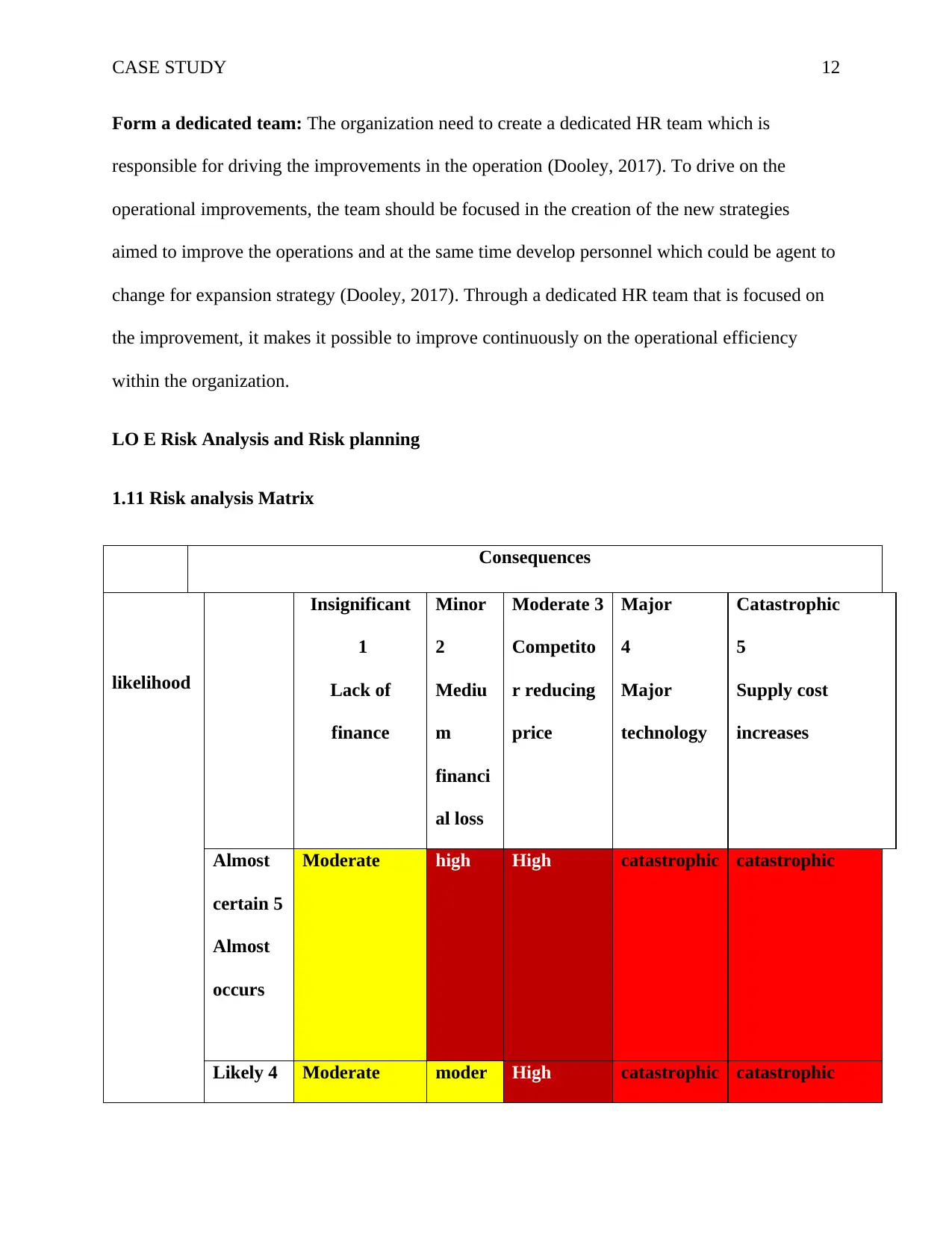
CASE STUDY 12
Form a dedicated team: The organization need to create a dedicated HR team which is
responsible for driving the improvements in the operation (Dooley, 2017). To drive on the
operational improvements, the team should be focused in the creation of the new strategies
aimed to improve the operations and at the same time develop personnel which could be agent to
change for expansion strategy (Dooley, 2017). Through a dedicated HR team that is focused on
the improvement, it makes it possible to improve continuously on the operational efficiency
within the organization.
LO E Risk Analysis and Risk planning
1.11 Risk analysis Matrix
Consequences
likelihood
Insignificant
1
Lack of
finance
Minor
2
Mediu
m
financi
al loss
Moderate 3
Competito
r reducing
price
Major
4
Major
technology
Catastrophic
5
Supply cost
increases
Almost
certain 5
Almost
occurs
Moderate high High catastrophic catastrophic
Likely 4 Moderate moder High catastrophic catastrophic
Form a dedicated team: The organization need to create a dedicated HR team which is
responsible for driving the improvements in the operation (Dooley, 2017). To drive on the
operational improvements, the team should be focused in the creation of the new strategies
aimed to improve the operations and at the same time develop personnel which could be agent to
change for expansion strategy (Dooley, 2017). Through a dedicated HR team that is focused on
the improvement, it makes it possible to improve continuously on the operational efficiency
within the organization.
LO E Risk Analysis and Risk planning
1.11 Risk analysis Matrix
Consequences
likelihood
Insignificant
1
Lack of
finance
Minor
2
Mediu
m
financi
al loss
Moderate 3
Competito
r reducing
price
Major
4
Major
technology
Catastrophic
5
Supply cost
increases
Almost
certain 5
Almost
occurs
Moderate high High catastrophic catastrophic
Likely 4 Moderate moder High catastrophic catastrophic
You're viewing a preview
Unlock full access by subscribing today!
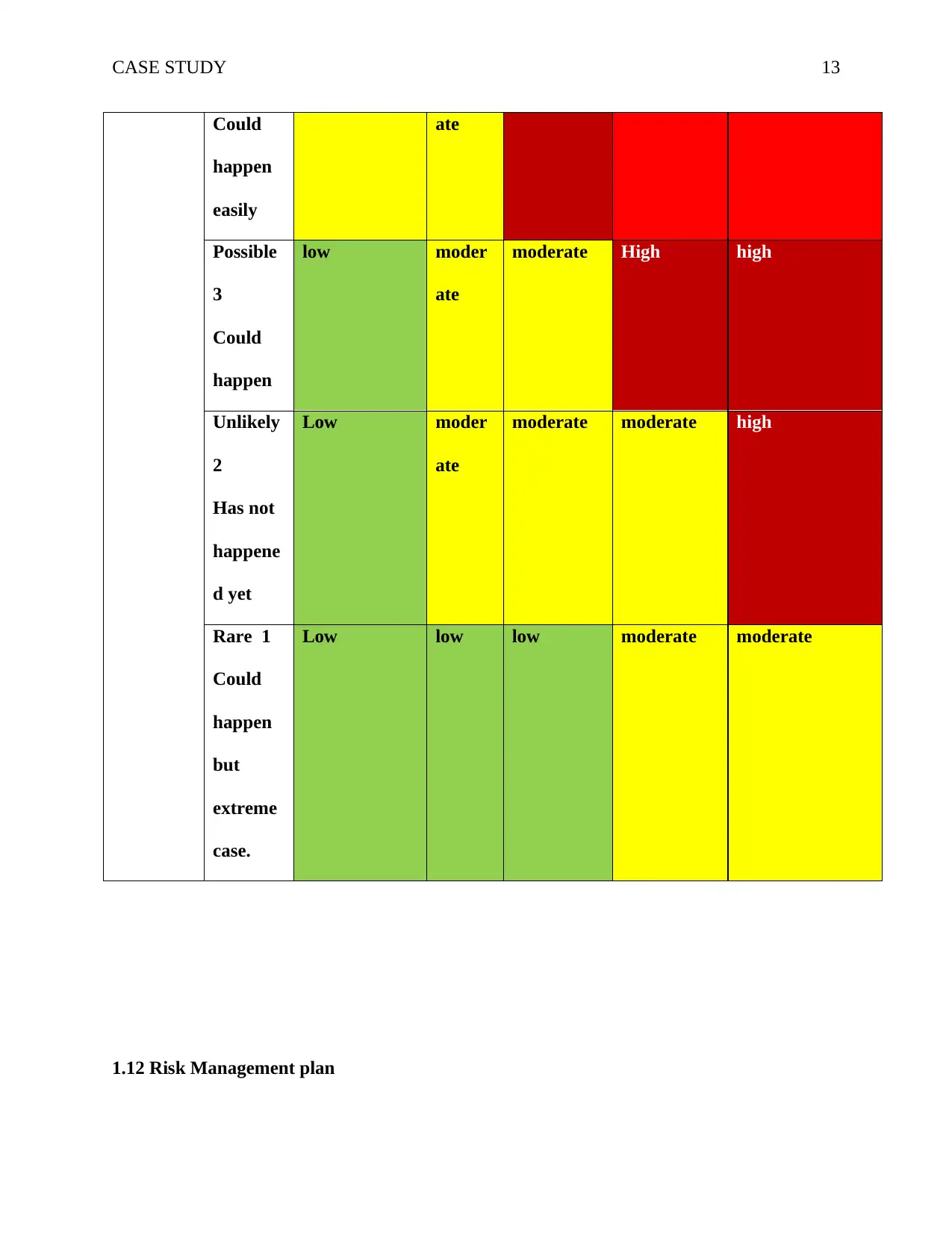
CASE STUDY 13
Could
happen
easily
ate
Possible
3
Could
happen
low moder
ate
moderate High high
Unlikely
2
Has not
happene
d yet
Low moder
ate
moderate moderate high
Rare 1
Could
happen
but
extreme
case.
Low low low moderate moderate
1.12 Risk Management plan
Could
happen
easily
ate
Possible
3
Could
happen
low moder
ate
moderate High high
Unlikely
2
Has not
happene
d yet
Low moder
ate
moderate moderate high
Rare 1
Could
happen
but
extreme
case.
Low low low moderate moderate
1.12 Risk Management plan
Paraphrase This Document
Need a fresh take? Get an instant paraphrase of this document with our AI Paraphraser
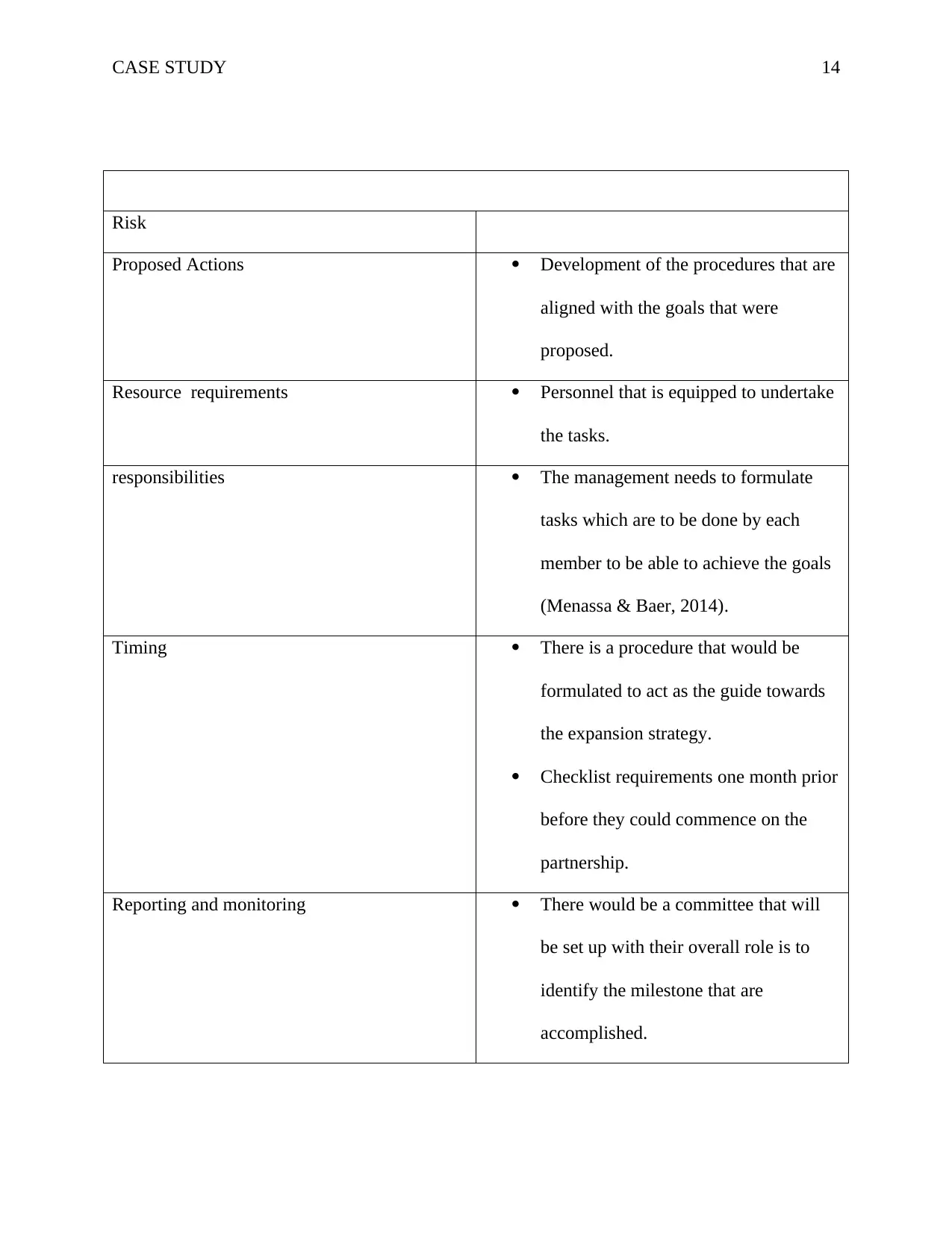
CASE STUDY 14
Risk
Proposed Actions Development of the procedures that are
aligned with the goals that were
proposed.
Resource requirements Personnel that is equipped to undertake
the tasks.
responsibilities The management needs to formulate
tasks which are to be done by each
member to be able to achieve the goals
(Menassa & Baer, 2014).
Timing There is a procedure that would be
formulated to act as the guide towards
the expansion strategy.
Checklist requirements one month prior
before they could commence on the
partnership.
Reporting and monitoring There would be a committee that will
be set up with their overall role is to
identify the milestone that are
accomplished.
Risk
Proposed Actions Development of the procedures that are
aligned with the goals that were
proposed.
Resource requirements Personnel that is equipped to undertake
the tasks.
responsibilities The management needs to formulate
tasks which are to be done by each
member to be able to achieve the goals
(Menassa & Baer, 2014).
Timing There is a procedure that would be
formulated to act as the guide towards
the expansion strategy.
Checklist requirements one month prior
before they could commence on the
partnership.
Reporting and monitoring There would be a committee that will
be set up with their overall role is to
identify the milestone that are
accomplished.
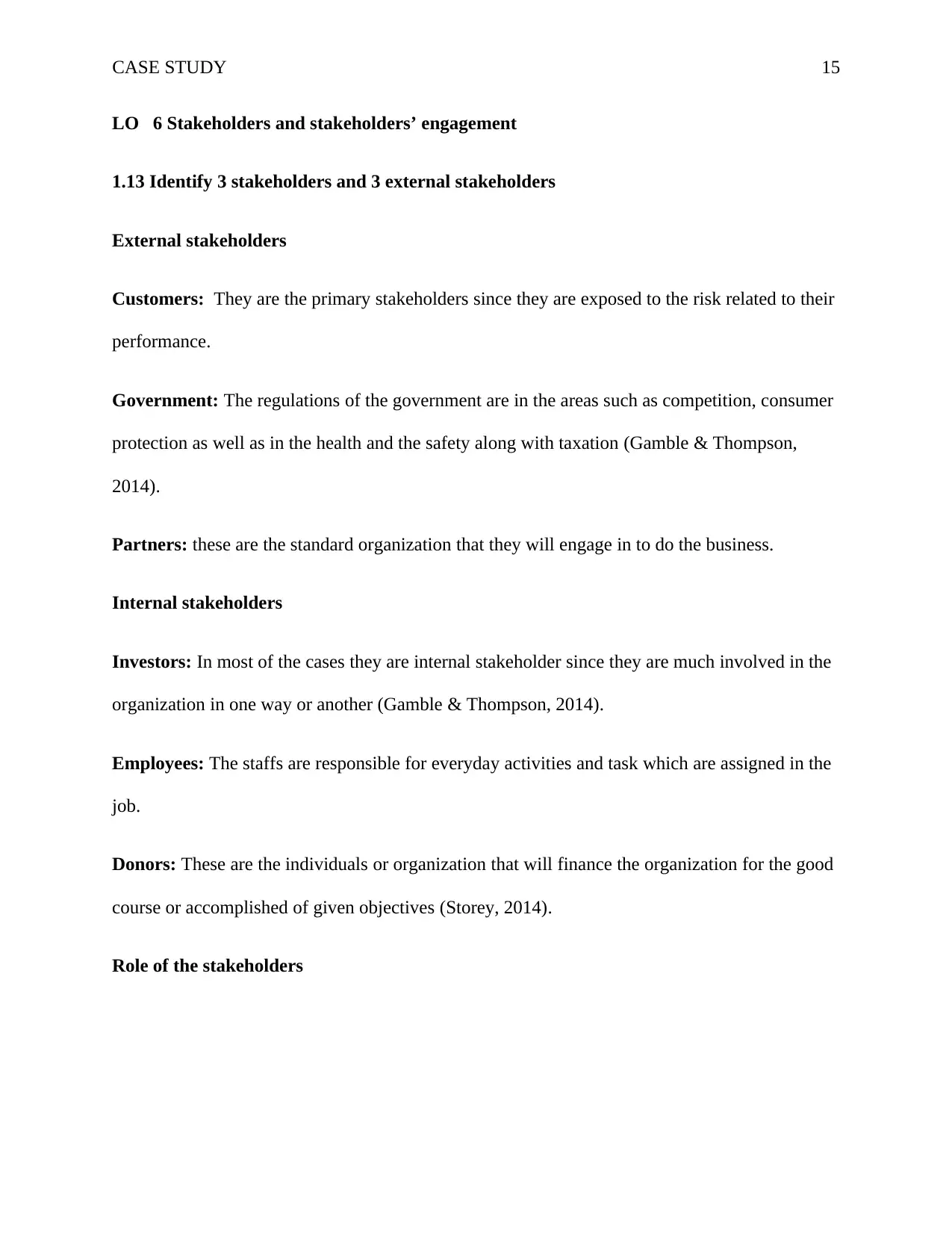
CASE STUDY 15
LO 6 Stakeholders and stakeholders’ engagement
1.13 Identify 3 stakeholders and 3 external stakeholders
External stakeholders
Customers: They are the primary stakeholders since they are exposed to the risk related to their
performance.
Government: The regulations of the government are in the areas such as competition, consumer
protection as well as in the health and the safety along with taxation (Gamble & Thompson,
2014).
Partners: these are the standard organization that they will engage in to do the business.
Internal stakeholders
Investors: In most of the cases they are internal stakeholder since they are much involved in the
organization in one way or another (Gamble & Thompson, 2014).
Employees: The staffs are responsible for everyday activities and task which are assigned in the
job.
Donors: These are the individuals or organization that will finance the organization for the good
course or accomplished of given objectives (Storey, 2014).
Role of the stakeholders
LO 6 Stakeholders and stakeholders’ engagement
1.13 Identify 3 stakeholders and 3 external stakeholders
External stakeholders
Customers: They are the primary stakeholders since they are exposed to the risk related to their
performance.
Government: The regulations of the government are in the areas such as competition, consumer
protection as well as in the health and the safety along with taxation (Gamble & Thompson,
2014).
Partners: these are the standard organization that they will engage in to do the business.
Internal stakeholders
Investors: In most of the cases they are internal stakeholder since they are much involved in the
organization in one way or another (Gamble & Thompson, 2014).
Employees: The staffs are responsible for everyday activities and task which are assigned in the
job.
Donors: These are the individuals or organization that will finance the organization for the good
course or accomplished of given objectives (Storey, 2014).
Role of the stakeholders
You're viewing a preview
Unlock full access by subscribing today!
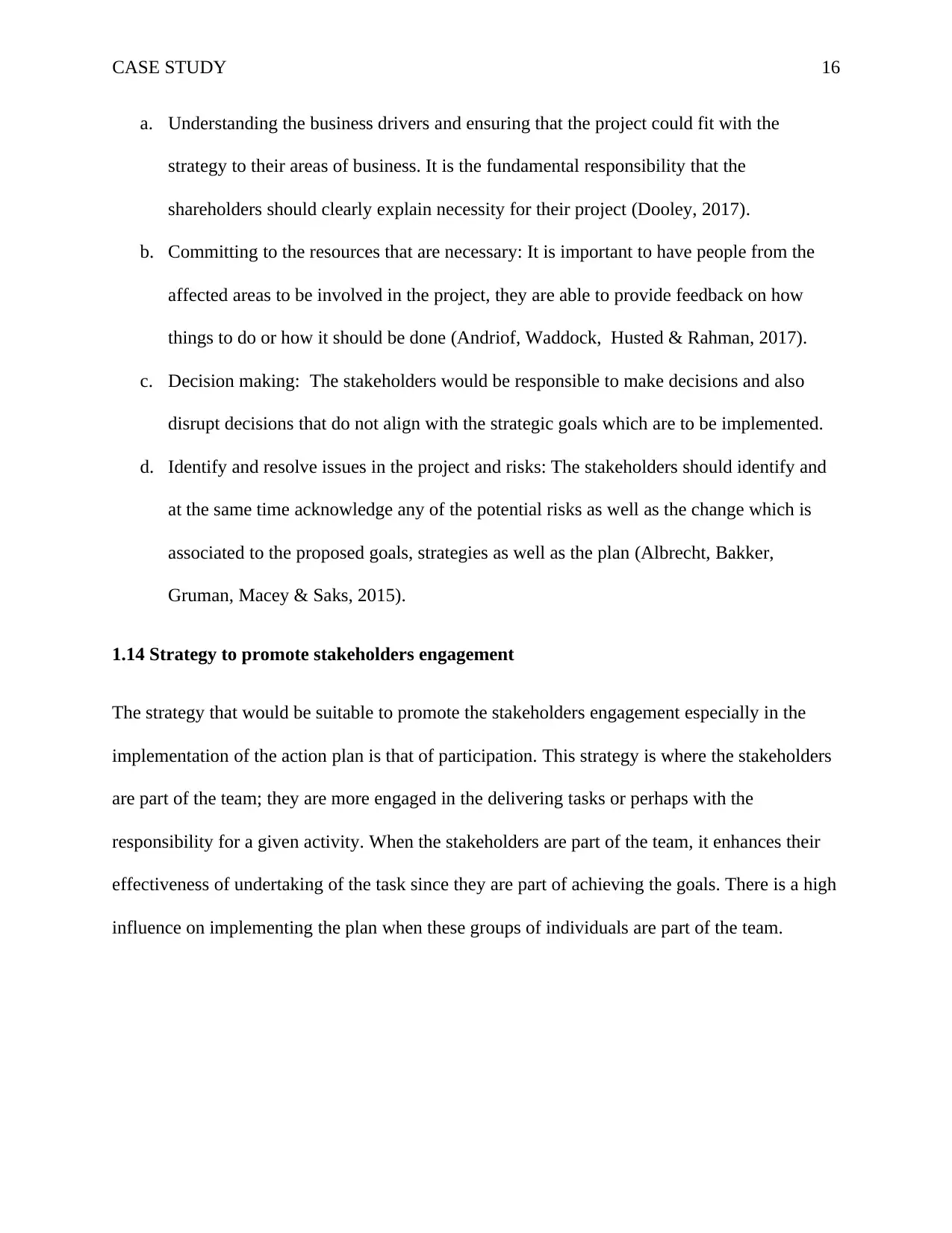
CASE STUDY 16
a. Understanding the business drivers and ensuring that the project could fit with the
strategy to their areas of business. It is the fundamental responsibility that the
shareholders should clearly explain necessity for their project (Dooley, 2017).
b. Committing to the resources that are necessary: It is important to have people from the
affected areas to be involved in the project, they are able to provide feedback on how
things to do or how it should be done (Andriof, Waddock, Husted & Rahman, 2017).
c. Decision making: The stakeholders would be responsible to make decisions and also
disrupt decisions that do not align with the strategic goals which are to be implemented.
d. Identify and resolve issues in the project and risks: The stakeholders should identify and
at the same time acknowledge any of the potential risks as well as the change which is
associated to the proposed goals, strategies as well as the plan (Albrecht, Bakker,
Gruman, Macey & Saks, 2015).
1.14 Strategy to promote stakeholders engagement
The strategy that would be suitable to promote the stakeholders engagement especially in the
implementation of the action plan is that of participation. This strategy is where the stakeholders
are part of the team; they are more engaged in the delivering tasks or perhaps with the
responsibility for a given activity. When the stakeholders are part of the team, it enhances their
effectiveness of undertaking of the task since they are part of achieving the goals. There is a high
influence on implementing the plan when these groups of individuals are part of the team.
a. Understanding the business drivers and ensuring that the project could fit with the
strategy to their areas of business. It is the fundamental responsibility that the
shareholders should clearly explain necessity for their project (Dooley, 2017).
b. Committing to the resources that are necessary: It is important to have people from the
affected areas to be involved in the project, they are able to provide feedback on how
things to do or how it should be done (Andriof, Waddock, Husted & Rahman, 2017).
c. Decision making: The stakeholders would be responsible to make decisions and also
disrupt decisions that do not align with the strategic goals which are to be implemented.
d. Identify and resolve issues in the project and risks: The stakeholders should identify and
at the same time acknowledge any of the potential risks as well as the change which is
associated to the proposed goals, strategies as well as the plan (Albrecht, Bakker,
Gruman, Macey & Saks, 2015).
1.14 Strategy to promote stakeholders engagement
The strategy that would be suitable to promote the stakeholders engagement especially in the
implementation of the action plan is that of participation. This strategy is where the stakeholders
are part of the team; they are more engaged in the delivering tasks or perhaps with the
responsibility for a given activity. When the stakeholders are part of the team, it enhances their
effectiveness of undertaking of the task since they are part of achieving the goals. There is a high
influence on implementing the plan when these groups of individuals are part of the team.
Paraphrase This Document
Need a fresh take? Get an instant paraphrase of this document with our AI Paraphraser

CASE STUDY 17
References
References
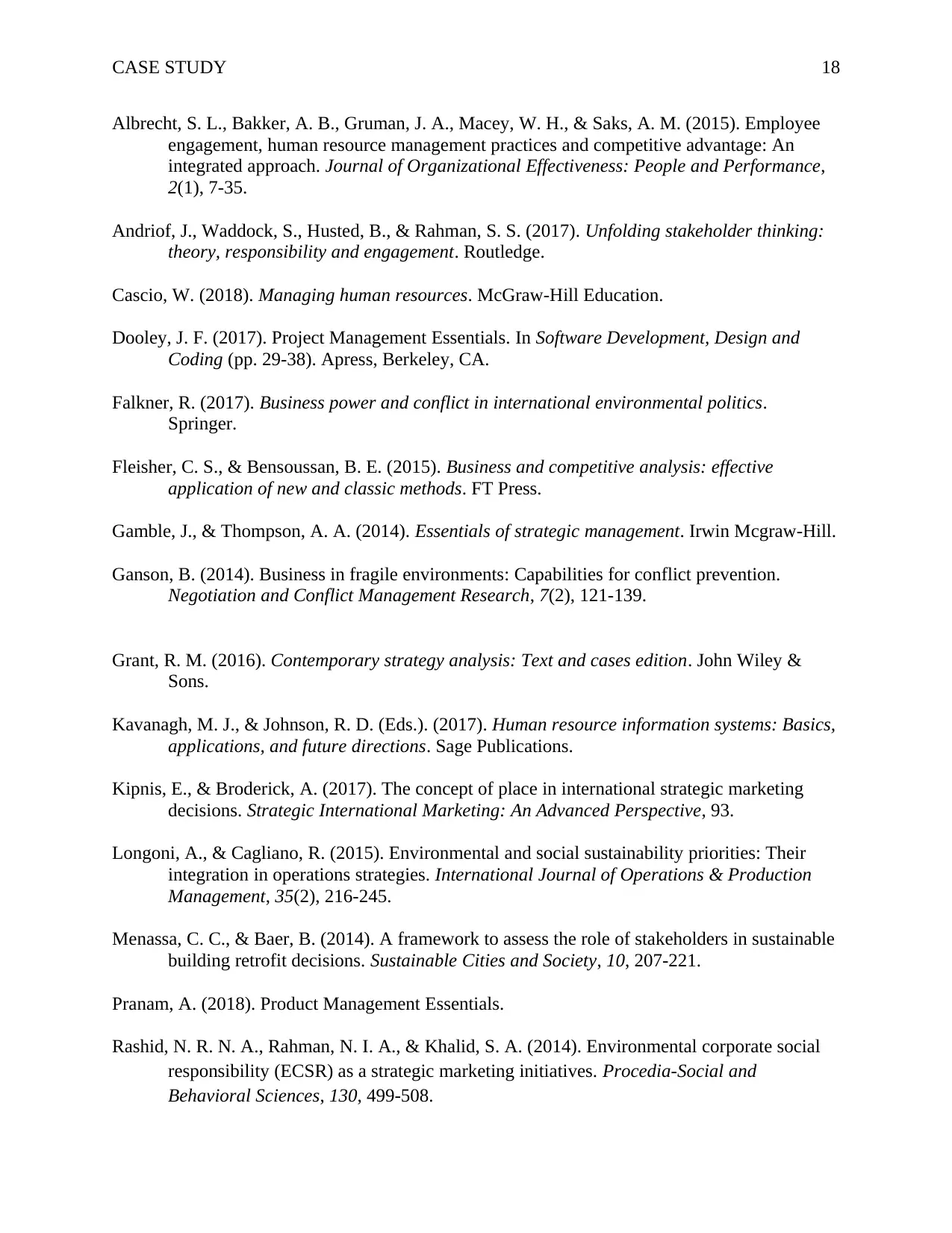
CASE STUDY 18
Albrecht, S. L., Bakker, A. B., Gruman, J. A., Macey, W. H., & Saks, A. M. (2015). Employee
engagement, human resource management practices and competitive advantage: An
integrated approach. Journal of Organizational Effectiveness: People and Performance,
2(1), 7-35.
Andriof, J., Waddock, S., Husted, B., & Rahman, S. S. (2017). Unfolding stakeholder thinking:
theory, responsibility and engagement. Routledge.
Cascio, W. (2018). Managing human resources. McGraw-Hill Education.
Dooley, J. F. (2017). Project Management Essentials. In Software Development, Design and
Coding (pp. 29-38). Apress, Berkeley, CA.
Falkner, R. (2017). Business power and conflict in international environmental politics.
Springer.
Fleisher, C. S., & Bensoussan, B. E. (2015). Business and competitive analysis: effective
application of new and classic methods. FT Press.
Gamble, J., & Thompson, A. A. (2014). Essentials of strategic management. Irwin Mcgraw-Hill.
Ganson, B. (2014). Business in fragile environments: Capabilities for conflict prevention.
Negotiation and Conflict Management Research, 7(2), 121-139.
Grant, R. M. (2016). Contemporary strategy analysis: Text and cases edition. John Wiley &
Sons.
Kavanagh, M. J., & Johnson, R. D. (Eds.). (2017). Human resource information systems: Basics,
applications, and future directions. Sage Publications.
Kipnis, E., & Broderick, A. (2017). The concept of place in international strategic marketing
decisions. Strategic International Marketing: An Advanced Perspective, 93.
Longoni, A., & Cagliano, R. (2015). Environmental and social sustainability priorities: Their
integration in operations strategies. International Journal of Operations & Production
Management, 35(2), 216-245.
Menassa, C. C., & Baer, B. (2014). A framework to assess the role of stakeholders in sustainable
building retrofit decisions. Sustainable Cities and Society, 10, 207-221.
Pranam, A. (2018). Product Management Essentials.
Rashid, N. R. N. A., Rahman, N. I. A., & Khalid, S. A. (2014). Environmental corporate social
responsibility (ECSR) as a strategic marketing initiatives. Procedia-Social and
Behavioral Sciences, 130, 499-508.
Albrecht, S. L., Bakker, A. B., Gruman, J. A., Macey, W. H., & Saks, A. M. (2015). Employee
engagement, human resource management practices and competitive advantage: An
integrated approach. Journal of Organizational Effectiveness: People and Performance,
2(1), 7-35.
Andriof, J., Waddock, S., Husted, B., & Rahman, S. S. (2017). Unfolding stakeholder thinking:
theory, responsibility and engagement. Routledge.
Cascio, W. (2018). Managing human resources. McGraw-Hill Education.
Dooley, J. F. (2017). Project Management Essentials. In Software Development, Design and
Coding (pp. 29-38). Apress, Berkeley, CA.
Falkner, R. (2017). Business power and conflict in international environmental politics.
Springer.
Fleisher, C. S., & Bensoussan, B. E. (2015). Business and competitive analysis: effective
application of new and classic methods. FT Press.
Gamble, J., & Thompson, A. A. (2014). Essentials of strategic management. Irwin Mcgraw-Hill.
Ganson, B. (2014). Business in fragile environments: Capabilities for conflict prevention.
Negotiation and Conflict Management Research, 7(2), 121-139.
Grant, R. M. (2016). Contemporary strategy analysis: Text and cases edition. John Wiley &
Sons.
Kavanagh, M. J., & Johnson, R. D. (Eds.). (2017). Human resource information systems: Basics,
applications, and future directions. Sage Publications.
Kipnis, E., & Broderick, A. (2017). The concept of place in international strategic marketing
decisions. Strategic International Marketing: An Advanced Perspective, 93.
Longoni, A., & Cagliano, R. (2015). Environmental and social sustainability priorities: Their
integration in operations strategies. International Journal of Operations & Production
Management, 35(2), 216-245.
Menassa, C. C., & Baer, B. (2014). A framework to assess the role of stakeholders in sustainable
building retrofit decisions. Sustainable Cities and Society, 10, 207-221.
Pranam, A. (2018). Product Management Essentials.
Rashid, N. R. N. A., Rahman, N. I. A., & Khalid, S. A. (2014). Environmental corporate social
responsibility (ECSR) as a strategic marketing initiatives. Procedia-Social and
Behavioral Sciences, 130, 499-508.
You're viewing a preview
Unlock full access by subscribing today!
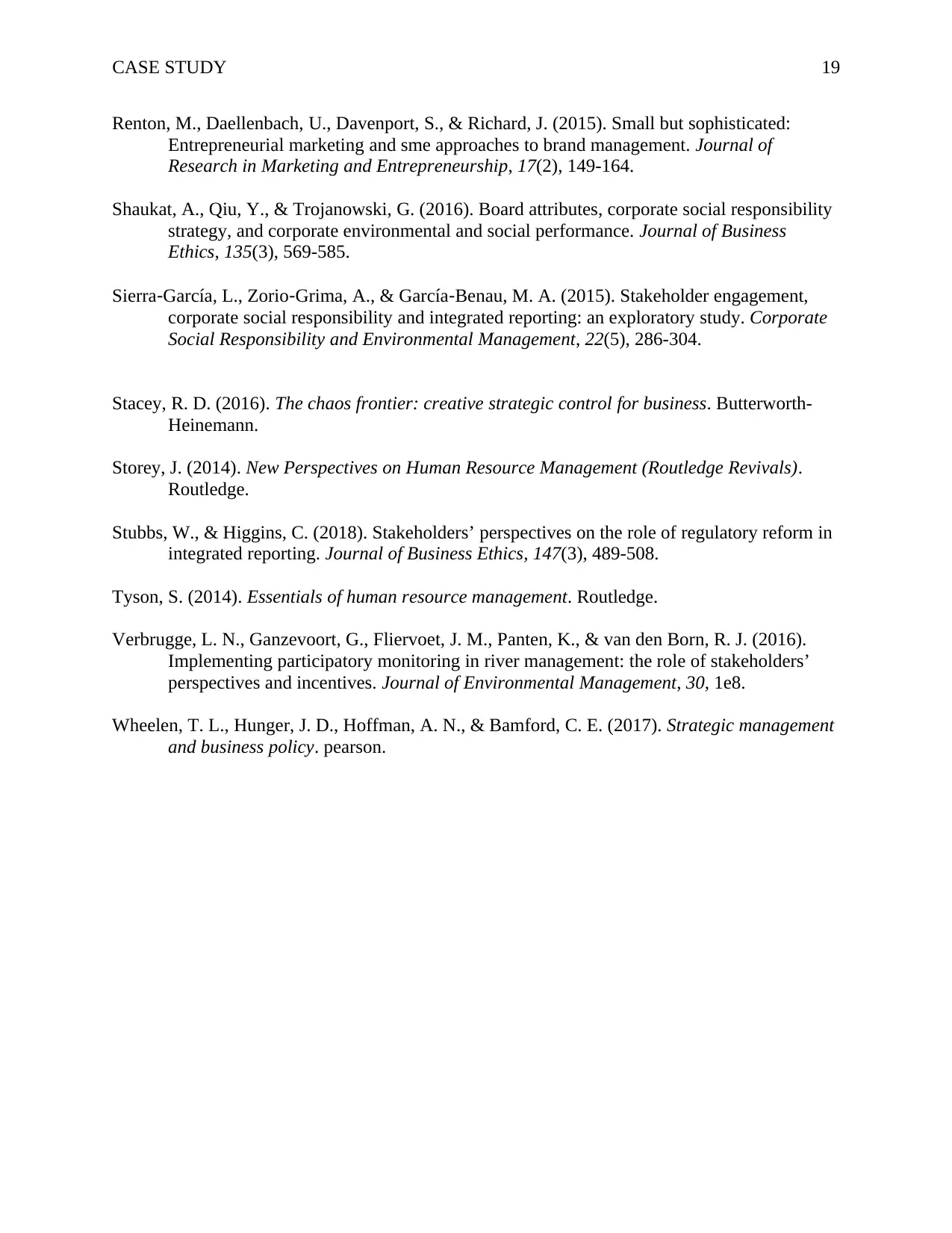
CASE STUDY 19
Renton, M., Daellenbach, U., Davenport, S., & Richard, J. (2015). Small but sophisticated:
Entrepreneurial marketing and sme approaches to brand management. Journal of
Research in Marketing and Entrepreneurship, 17(2), 149-164.
Shaukat, A., Qiu, Y., & Trojanowski, G. (2016). Board attributes, corporate social responsibility
strategy, and corporate environmental and social performance. Journal of Business
Ethics, 135(3), 569-585.
Sierra‐García, L., Zorio‐Grima, A., & García‐Benau, M. A. (2015). Stakeholder engagement,
corporate social responsibility and integrated reporting: an exploratory study. Corporate
Social Responsibility and Environmental Management, 22(5), 286-304.
Stacey, R. D. (2016). The chaos frontier: creative strategic control for business. Butterworth-
Heinemann.
Storey, J. (2014). New Perspectives on Human Resource Management (Routledge Revivals).
Routledge.
Stubbs, W., & Higgins, C. (2018). Stakeholders’ perspectives on the role of regulatory reform in
integrated reporting. Journal of Business Ethics, 147(3), 489-508.
Tyson, S. (2014). Essentials of human resource management. Routledge.
Verbrugge, L. N., Ganzevoort, G., Fliervoet, J. M., Panten, K., & van den Born, R. J. (2016).
Implementing participatory monitoring in river management: the role of stakeholders’
perspectives and incentives. Journal of Environmental Management, 30, 1e8.
Wheelen, T. L., Hunger, J. D., Hoffman, A. N., & Bamford, C. E. (2017). Strategic management
and business policy. pearson.
Renton, M., Daellenbach, U., Davenport, S., & Richard, J. (2015). Small but sophisticated:
Entrepreneurial marketing and sme approaches to brand management. Journal of
Research in Marketing and Entrepreneurship, 17(2), 149-164.
Shaukat, A., Qiu, Y., & Trojanowski, G. (2016). Board attributes, corporate social responsibility
strategy, and corporate environmental and social performance. Journal of Business
Ethics, 135(3), 569-585.
Sierra‐García, L., Zorio‐Grima, A., & García‐Benau, M. A. (2015). Stakeholder engagement,
corporate social responsibility and integrated reporting: an exploratory study. Corporate
Social Responsibility and Environmental Management, 22(5), 286-304.
Stacey, R. D. (2016). The chaos frontier: creative strategic control for business. Butterworth-
Heinemann.
Storey, J. (2014). New Perspectives on Human Resource Management (Routledge Revivals).
Routledge.
Stubbs, W., & Higgins, C. (2018). Stakeholders’ perspectives on the role of regulatory reform in
integrated reporting. Journal of Business Ethics, 147(3), 489-508.
Tyson, S. (2014). Essentials of human resource management. Routledge.
Verbrugge, L. N., Ganzevoort, G., Fliervoet, J. M., Panten, K., & van den Born, R. J. (2016).
Implementing participatory monitoring in river management: the role of stakeholders’
perspectives and incentives. Journal of Environmental Management, 30, 1e8.
Wheelen, T. L., Hunger, J. D., Hoffman, A. N., & Bamford, C. E. (2017). Strategic management
and business policy. pearson.
1 out of 19
Related Documents
Your All-in-One AI-Powered Toolkit for Academic Success.
+13062052269
info@desklib.com
Available 24*7 on WhatsApp / Email
![[object Object]](/_next/static/media/star-bottom.7253800d.svg)
Unlock your academic potential
© 2024 | Zucol Services PVT LTD | All rights reserved.





